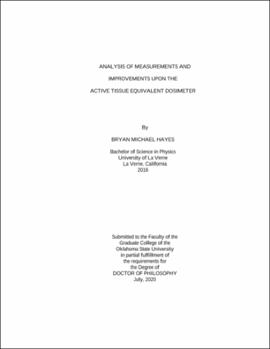| dc.contributor.advisor | Benton, Eric | |
| dc.contributor.author | Hayes, Bryan Michael | |
| dc.date.accessioned | 2021-11-29T21:46:26Z | |
| dc.date.available | 2021-11-29T21:46:26Z | |
| dc.date.issued | 2020-07 | |
| dc.identifier.uri | https://hdl.handle.net/11244/331280 | |
| dc.description.abstract | The Oklahoma State University Radiation Physics Lab is nearing completion in the development of a tissue equivalent proportional counter (TEPC), the Active Tissue Equivalent Dosimeter (ATED), to monitor cosmic radiation exposure of astronauts and aircrew. This dissertation is a detailed analysis of ATED measurements in the space and atmospheric radiation environments, and a comprehensive description of improvements made on the ATED instrument. The ATED was sent to the International Space Station (ISS) on May 21, 2018. ATED measurements were analyzed in terms of time, latitude, longitude, and altitude of the ISS in order to correlate with features that exist in the ISS orbit. Comparisons with computer simulations and previous measurements on the ISS strongly indicate that the ATED functioned as designed. The ATED was exposed to a similar neutron energy spectrum to that found at aviation altitudes at the Los Alamos Neutron Science Center (LANSCE). Comparisons of ATED measurements at LANSCE with the same measurement by a NASA TEPC and simulations in MCNP_6.2 demonstrate that ATED has the appropriate response to these neutrons. ATED has also been shown to be useful at charged particle accelerators, including the development of a new method to assess the suitability of materials for use as radiation shielding in spacecraft, concentrating on their propensity to produce secondary neutrons. Areas of improvement have been identified and implemented into recent ATED models. This includes the validation or refutation of previously made assumptions and the implementation of new hardware/designs. Cost was significantly reduced by programming a Red Pitaya to function as a dual-input spectrometer, saving $8000 per ATED instrument. For the first time, the individual contributions by positive ions and electrons to pulse amplitude inside a proportional counter have been measured. This demonstrated that positive ions contribute anywhere from 4-12 times more to pulse amplitude than electrons, refuting previous assumptions that only electrons contribute to pulse amplitude. It was demonstrated for the first time that ATED collects 100% of the separated charge inside its active volume. | |
| dc.format | application/pdf | |
| dc.language | en_US | |
| dc.rights | Copyright is held by the author who has granted the Oklahoma State University Library the non-exclusive right to share this material in its institutional repository. Contact Digital Library Services at lib-dls@okstate.edu or 405-744-9161 for the permission policy on the use, reproduction or distribution of this material. | |
| dc.title | Analysis of measurements and improvements upon the Active Tissue Equivalent Dosimeter | |
| dc.contributor.committeeMember | Rosenberger, Al | |
| dc.contributor.committeeMember | Borunda, Mario | |
| dc.contributor.committeeMember | Vaidyanathan, Ranji | |
| osu.filename | Hayes_okstate_0664D_16819.pdf | |
| osu.accesstype | Open Access | |
| dc.type.genre | Dissertation | |
| dc.type.material | Text | |
| thesis.degree.discipline | Physics | |
| thesis.degree.grantor | Oklahoma State University | |
